First ride: Bimota DB7 road test review
Bimota, sadly now without a UK importer, continue making some of the prettiest bikes in the world. The 1098-powered DB7 is divine...
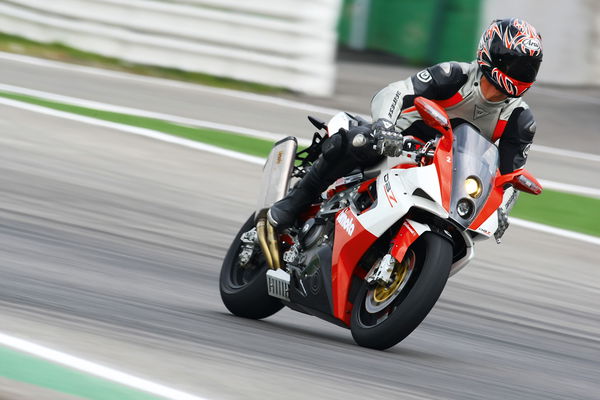
height=10> | |
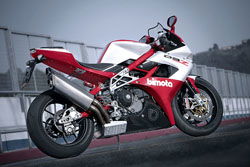 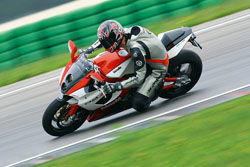 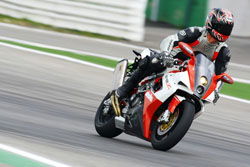 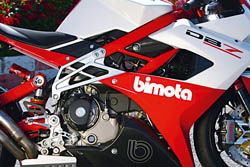 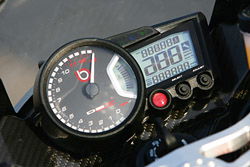  Bimota DB7 onboard at TsukubaThe bike ahead was half-way down Misano’s back straight when I exited the preceding right-hand bend, but it didn’t stay that way for long. As I crouched behind the DB7’s low screen and tap-tapped through the sweet-shifting gearbox, the Bimota’s eight-valve V-twin motor punched the bike forward in a 160-horse charge that sent the following right-hand kink rushing into view at a scary rate. By the time I’d held my breath, backed-off a touch then flicked the DB7 through the 100mph-plus, knee-brushing-the-deck kink, the gap to the bike ahead had halved; and the following short straight shrunk it further. I barely gained through the next two turns but on the following start-finish straight I quickly caught and blasted past a Bimota that turned out to be — as I’d guessed from the speed differential — not an identical DB7 but its aircooled predecessor, the DB5. Overtaking a much slower bike proved little about the DB7, but illustrated just why Bimota’s latest model is so important to the reborn Rimini firm. That DB5 was a light, sweet-handling sports bike with a good rider on board. But when you’re giving away more than 50bhp to the opposition, you’ve got a problem — whether you’re riding round Misano or trying to sell expensive superbikes in a showroom. Bimota boss Roberto Comini knows that all too well. The 92bhp DB5 and its naked derivative the DB6 have done a good job of leading Bimota’s revival since the petrochemical millionaire took control of the financially troubled firm four years ago. But Bimota needed a flagship with the horsepower to compete on equal terms. The DB7, powered by the 160bhp, eight-valve V-twin motor from Ducati’s 1098, has been created to do just that. In looks and layout the DB7 is on a different level to the DB5, due largely to the power advantage of over 50 per cent provided by the liquid-cooled Testastretta Evoluzione engine visible through the gaps in its slinky carbon-fibre fairing. The 1099cc desmo unit is mechanically standard, complete with the elliptical throttle bodies as developed by Ducati in MotoGP. Bimota has fitted a new injection system that combines Magneti Marelli 12-hole injectors with a tuneable ECU from Bologna-based specialist Walbro. Frame design is unique and elegant, combining a top section of oval-section chrome-molybdenum steel tube with side-plates machined from billet aluminium. There’s no rear subframe; just a self-supporting carbon-fibre seat unit. As with the 1098, the engine is a stressed member of the chassis. The swing-arm uses a similar blend of oval steel tubes and aluminium forgings, and works the vertical shock via a rising-rate linkage. Other chassis parts are suitably upmarket. Billet aluminium triple clamps hold 43mm Marzocchi racing forks. The Extreme Tech shock is tuneable for high- and low-speed compression and rebound damping; ride height can be adjusted via an eccentric in the top shock mount. Bimota designed the aluminium mounts for the Brembo Monobloc radial calipers, and also the forged aluminium wheels that are 1kg lighter than their 1098 equivalents. At a claimed 172kg dry, the DB7 is lighter than the 1098 by the same amount. All bodywork is carbon-fibre, as are parts including the chainguard and the cover of the dry clutch. Along with neatly machined billet aluminium pieces including the footrest assemblies and control levers they make for a beautifully detailed machine, though when examining it in the Misano pit-lane I couldn’t help thinking that the fairing’s integrated screen, which incorporates round holes for the twin headlights, looked like a bit of an afterthought. Out on the track, there was certainly no lack of top-end horsepower from this Bimota, which charged forward at every opportunity, accompanied by a deep V-twin bark from the silencer behind my right boot. Misano’s new direction means that the fastest part of the circuit is now immediately before that bottle-testingly rapid kink, by which point the DB7 was into fifth gear and still stampeding towards a likely top speed approaching 190mph. Such was the desmo motor’s midrange strength that I didn’t need to cane it to the 10,500rpm redline through the gears. There was always smooth grunt on tap; enough even from below 6,000rpm to send the DB7 barrelling forward when I’d entered an unfamiliar turn in too high a gear. You can be lazy with the gears if you wish. Whether the DB7 gave a notable increase below 7,000rpm, as Bimota claims, was hard to tell, but it certainly punched hard through the midrange, and also had impressively crisp throttle response. At least, that was true in my first session. A couple of hours later I was surprised to find the same bike hesitating momentarily as I accelerated out of some turns. The glitch was serious enough to be annoying and even potentially dangerous. Bimota’s injection specialist Davide Comandini reckoned the temporary problem could have been caused by the ignition having been turned off and then immediately on again, which can confuse the ECU. The problem didn’t return after he’d reset the system via his PC, so hopefully he’s right. Bimota has a history of modifying injection systems, sometimes with unfortunate results. A reliable ECU is preferable to one that gives trouble in my book. There were no such problems with the DB7’s chassis, though the bike was initially set up too soft for my 85kg weight, so wasn’t much fun in the first session. Adding shock preload and compression damping cured its tendency to squat at the rear. Reducing fork preload improved feel from the front end, which had been slightly harsh. Suddenly the Bimota was transformed into a light and responsive bike that could be thrown onto its side with a flick of the clip-ons, and which steered with real precision and feedback for the rider. It stayed impressively stable under hard acceleration, too, despite sharing its short, 1430mm wheelbase and would give a 1098S a good fight on road or track. Tyre choice might be crucial in such a clash. Continental’s Race Attacks aren’t the grippiest super-sport rubber but gave me no nasty moments at Misano, despite the bike’s near infinite ground clearance. The only chassis related problem I did have, once the suspension was dialled in, concerned the brakes. There was nothing wrong with the fearsomely powerful Brembo system, whose Monobloc calipers can be matched with 298mm rather than the standard 320mm discs if preferred. Being tall, my only difficulty was preventing myself being pitched forward by the combination of braking force and low clip-on bars. The tendency to arrive at corners sitting on the petrol tank considerably reduced my ability to make full use of the Bimota’s stopping potential. Some shorter riders had the same problem, and a wider fuel tank would give more chance of using knee pressure to aid stability and control when hard on the anchors. But it’s hardly fair to criticise the DB7 too severely for a problem that also afflicts the 1098, and which I’ve previously suffered most when testing MotoGP bikes, with their similarly compact size and fierce braking ability. Inevitably the DB7’s other drawbacks concern price and availability. Comparisons with the 1098S seem less favourable given that its price will be over £20,000 — closer to that of Ducati’s lighter, more powerful and traction-control equipped 1098R. And that’s if you can find a DB7 to buy. Bimota recently split with previous UK importer Moto Cinelli. This bike might not match the sheer performance of Ducati’s homologation R-model, but it’s hardly lacking in horsepower. Bimota badly needed a model with the speed to match its style and handling ability. The DB7 provides just that — on Misano’s back straight or anywhere else. It’s beautful, rapid and slightly temperamental, like all Bimotas past or present. Whether it can put the Rimini factory back on the map in this country remains to be seen. INDUSTRY INTERVIEWRoberto Comini, Bimota Chairman “I was always convinced that Bimota had a successful future, if run correctly. That’s why I have invested 6 million euro in the company. My other business has more than 700 employees so I’m very busy, but now Bimota is my passion. Why did I take this challenge, when Bimota has so often struggled? Well, I have never lost in my life. I am convinced that if somebody works hard, if they are loyal, reliable, and collaborate well with other people, they will be successful. The motorcycle industry is very difficult, it’s true. We have not won the war yet, but we have won many battles. In 2004, the year I took control, Bimota sold only 80 bikes. The following year the number was almost 300; in 2006, 420; and last year almost 500. This year our objective is to sell 600 bikes — and half will be the DB7. Having a model with high performance is very important for Bimota. Our objective is to sell 1,000 bikes per year. Bimota must remain capable of innovation and of producing really special bikes. For this reason our relationship with Ducati is very important. Maybe in the future we will develop another model with a Japanese engine, but at the moment it’s not a priority.” |

The bike ahead was half-way down Misano’s back straight when I exited the preceding right-hand bend, but it didn’t stay that way for long. As I crouched behind the DB7’s low screen and tap-tapped through the sweet-shifting gearbox, the Bimota’s eight-valve V-twin motor punched the bike forward in a 160-horse charge that sent the following right-hand kink rushing into view at a scary rate.
By the time I’d held my breath, backed-off a touch then flicked the DB7 through the 100mph-plus, knee-brushing-the-deck kink, the gap to the bike ahead had halved; and the following short straight shrunk it further. I barely gained through the next two turns but on the following start-finish straight I quickly caught and blasted past a Bimota that turned out to be — as I’d guessed from the speed differential — not an identical DB7 but its aircooled predecessor, the DB5.
Overtaking a much slower bike proved little about the DB7, but illustrated just why Bimota’s latest model is so important to the reborn Rimini firm. That DB5 was a light, sweet-handling sports bike with a good rider on board. But when you’re giving away more than 50bhp to the opposition, you’ve got a problem — whether you’re riding round Misano or trying to sell expensive superbikes in a showroom.
Bimota boss Roberto Comini knows that all too well. The 92bhp DB5 and its naked derivative the DB6 have done a good job of leading Bimota’s revival since the petrochemical millionaire took control of the financially troubled firm four years ago. But Bimota needed a flagship with the horsepower to compete on equal terms. The DB7, powered by the 160bhp, eight-valve V-twin motor from Ducati’s 1098, has been created to do just that.
In looks and layout the DB7 is on a different level to the DB5, due largely to the power advantage of over 50 per cent provided by the liquid-cooled Testastretta Evoluzione engine visible through the gaps in its slinky carbon-fibre fairing. The 1099cc desmo unit is mechanically standard, complete with the elliptical throttle bodies as developed by Ducati in MotoGP. Bimota has fitted a new injection system that combines Magneti Marelli 12-hole injectors with a tuneable ECU from Bologna-based specialist Walbro.
Frame design is unique and elegant, combining a top section of oval-section chrome-molybdenum steel tube with side-plates machined from billet aluminium. There’s no rear subframe; just a self-supporting carbon-fibre seat unit. As with the 1098, the engine is a stressed member of the chassis. The swing-arm uses a similar blend of oval steel tubes and aluminium forgings, and works the vertical shock via a rising-rate linkage.
Other chassis parts are suitably upmarket. Billet aluminium triple clamps hold 43mm Marzocchi racing forks. The Extreme Tech shock is tuneable for high- and low-speed compression and rebound damping; ride height can be adjusted via an eccentric in the top shock mount. Bimota designed the aluminium mounts for the Brembo Monobloc radial calipers, and also the forged aluminium wheels that are 1kg lighter than their 1098 equivalents. At a claimed 172kg dry, the DB7 is lighter than the 1098 by the same amount.











